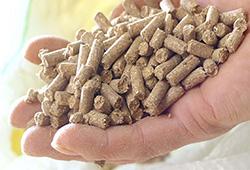1. the shortening and crushing of feed
Before feeding cattle, feed should be chopped and crushed to improve the palatability and utilization of feed. However, the feed should not be crushed too fine to avoid flap gastric obstruction, true gastritis and other digestive tract diseases. Fresh corn stalks and a variety of fresh grass cut into small pieces of 2 to 3 cm. Dry corn stalks and other coarse fiber content, tough roughage is best fed after rubbing with silk, soybean stalks and peanut seedlings are best crushed into coarse powder and fed. Corn fed to large cattle can be ground into 2 to 3 mm blocks, fed to calves when the powder to thin some. But soybean meal, wine lees and other smaller particles of feed do not need to be crushed twice.

2. change the ammonia for micro-silage
When feeding cattle with rice straw and wheat straw in the past, often use ammonia treatment first, that is, in the rice straw and wheat straw evenly sprayed with urea water and sealed to soften the feed, improve its palatability and digestibility. However, cattle are prone to urea poisoning when eating ammoniated feed, which may even lead to cattle death in serious cases. Therefore, many cattle farmers no longer use ammoniation treatment, but change ammoniation to micro-storage. In fact, there is little difference between the microsilage treatment and ammoniation except that the urea water is replaced by probiotic solution and the straw and wheat straw can be softened after microsilage. The odor is better than ammoniation treatment, cattle like it better and don't worry about urea poisoning.
3. Scientific matching of concentrate feeds
As herbivores, cattle need to eat a lot of food to feel full. Although most of the diet is roughage, scientific matching and reasonable supply of concentrate feed is the key to its growth. Cattle farmers should scientifically configure concentrated feeds according to the different growth stages and growth needs of cattle. Concentrated feeds are mostly energy feeds, such as corn and bran, which can account for about 70% of the total concentrated feed. However, wheat bran should not be overfed, as it can easily cause diarrhea and urinary stones in cattle. According to the size of cattle and the weather, a reasonable addition of bran, calves more cattle less, more summer and less winter, but at most not more than 15% of the total concentrated feed, followed by protein feed, namely soybean meal and urinary calculus.
4. the diversity of roughage with
Roughage should be diversified, the more types of roughage, the more comprehensive and balanced nutrition. If you feed only one kind of roughage to cattle, it is easy to have a deficiency of trace elements or vitamins. Roughage is mainly made from local resource-rich raw materials, such as corn straw, wheat straw, rice straw, etc.. And with green hay, fresh pasture grass, wine lees, etc. When conditions allow, it is best to mix 3~5 kinds of raw materials together. Talk about the mix of our cattle farm roughage, including silage corn straw 50%, wine lees 20%, wheat straw 10%, soybean straw (coarse meal) 10%, soybean pod skin 5%, alfalfa grass 3%, garlic peel and garlic straw 2%. 5. Fine and coarse mix.
